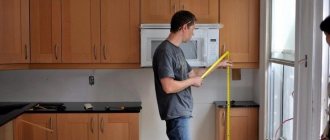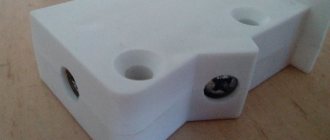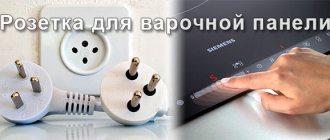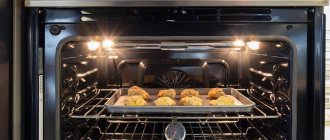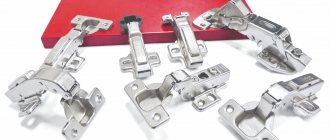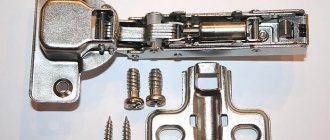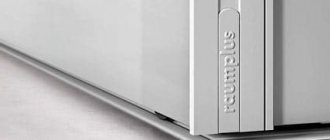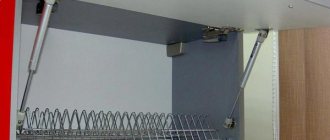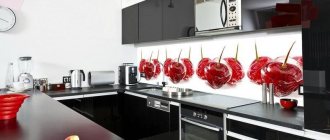SHARE ON SOCIAL NETWORKS
FacebookTwitterOkGoogle+PinterestVk
In order for the cooking process to be fast, high-quality and enjoyable, it is important to take into account a number of nuances. We are talking not only about the usable space in the kitchen, the correct choice of dishes, tools and appliances, but also about the peculiarities of their location in the room. One of the main factors for comfortable use of the kitchen space is the correct installation of the built-in oven. This article will tell you about the features of choosing equipment and its quick and most importantly safe installation.
When installing the oven, compliance with the rules is mandatory
Oven in the kitchen: purpose of the device
An oven in the kitchen is an indispensable assistant for any housewife and other family members who are passionate about the process of cooking. It's no secret that a dish cooked in the oven is much healthier than one fried in a frying pan using oil. Homemade pies baked in the oven are much more fluffy and flavorful than those purchased at a bakery.
No modern kitchen is complete without an oven.
An important criterion for choosing a device is, of course, personal preference, and the main condition for safe operation is proper installation of the device. Equipment manufacturers do not recommend installing ovens yourself, but at the same time, knowing the sequence of work, requirements for materials and connection features, you can install the oven yourself.
When purchasing an oven, you first need to decide on its type and type of power supply. It is equally important to decide on the manufacturer, specific model and location of the equipment. Taking into account the rules of ergonomics, even in a miniature kitchen you can successfully place a multifunctional oven. When going to the store, you should not forget about the functionality of the equipment. In this case, it is worth taking into account such criteria as the availability of cooking options, timers, readiness sensors, additional functions and temperature modes, as well as installation features of the oven.
The versatility of the oven is especially important for those people for whom cooking is not just a process, but a kind of art. For chefs who frequently use the appliance, it is important to have a self-cleaning function. It is worth considering the fact that you will have to pay significantly more for additional functions.
Oven: separate or dependent, and other selection options
You can determine a number of basic parameters that should be followed when choosing an oven. These include:
- safety;
Independent oven installed separately from the stove
- type of control;
- functionality;
- appearance;
- installation features.
Important! An electric oven belongs to the category of high-power household appliances, so the house must have appropriate electrical wiring, and the installation and connection of the oven itself occurs through a power cable to a special machine.
Safety requires the presence of gas control for gas appliances, and timers for electric ones. The control type can be automatic or mechanical. The mechanics are distinguished not only by price, but also by simplicity and reliability. At the same time, problems may arise when installing an oven of this type in the kitchen, since it does not fit into ordinary niches for embedding.
Multifunctional ovens are equipped with an electronic control unit. It has smaller dimensions, which makes a device with keyboard or touch buttons more convenient to use. In addition, you can save recipes for your favorite dishes in the device’s memory. It is also possible to install an electric oven with a combined type of control in standard niches. Such devices are usually equipped with an electronic display and mechanical regulators. The design of the oven must match the style of the room and match the color scheme with the rest of the appliances.
Dependent oven installed together with the hob
When installing an oven built under the hob, you should pay attention to the type of connection. It can be autonomous or connected to the hob. This factor is also important when choosing technology. Interconnected devices are connected using one power cable in accordance with the instructions. Independent ovens are connected via two different wires, so their installation is possible at any distance.
Where can I install an oven?
A common place for an oven is a cabinet. This option can be called very successful, but it is only suitable for fairly large rooms. A kitchen like this should have a lot of work surfaces. Some people build the oven into the island in the kitchen. This option is ideal if there are no small children in the apartment, and the oven itself is not used very often.
The oven can be built into a large cabinet - an additional work surface. This method is better than a pencil case, because an additional cabinet can be used for a variety of purposes: to place sugar bowls, various cans and much more on it. This method of placing the oven is perfect for a medium-sized room (without an excess of surfaces for cooking, but also without a shortage).
Installation of a built-in oven: types and configuration of equipment
Before installing a built-in oven, you should understand the types of this household appliance. In this regard, they are divided into electric and gas.
Gas ones are considered traditional, as they last in most kitchens for many years. Preference is given to gas ovens for their reasonable price and ease of use, since most of these ovens are built directly into the stove. At the same time, gas appliances also have their disadvantages, since dishes are cooked unevenly and there is a risk of burning. In addition, the use of natural gas itself is unsafe, and installing a gas oven clearly requires the involvement of an experienced professional in order to avoid disastrous consequences.
Electric ovens guarantee fast cooking and even baking of food. Their widespread installation began in megacities, where many multi-storey buildings do not have a natural gas connection. The cost of different models depends on the functionality and manufacturer. Installation of an electric oven requires reinforced, reliable wiring and a separate special RCD.
It is better to invite specialists to install kitchen appliances
Helpful advice! When choosing a gas oven, you should give preference to models that are equipped with leakage limiters, the so-called gas control function.
Ovens are also distinguished by type of installation. They can be dependent, which requires mandatory installation in tandem with the hob. Independent equipment are ovens that are installed as independent equipment. They can be built-in or free-standing. It is possible to install a built-in oven in a pencil case or in a special niche.
Non-standard option
There are many benefits to custom ovens. They are placed at the level of a person’s head, above and below the tabletop. Such ovens do not pose a danger to children; they are very easy to use. If the oven is located non-standardly, it is much better when its door is hinged and opens to the left or right. However, non-standard ovens also have disadvantages that are very important for buyers: for example, significant energy consumption and a higher price. However, they outperform standard models because they have wider functionality.
Non-standard ovens should be installed on perfectly flat surfaces. It is better to entrust installation work to experienced specialists who always take into account safety regulations. If you install the oven incorrectly, it can quickly fail. In order for the device to function as long as possible, you should carefully consider where it will be located.
How to install a built-in oven: choosing a place for appliances
An important aspect of the efficiency of using an oven is the correct location for its placement. It should be accessible and convenient. There are several typical locations.
Under the countertop is the simplest and most common variation of oven installation. The installation diagram of this type of oven is distinguished by its simplicity and consists in the fact that it is placed directly under the countertop in a specially designated niche away from the sink and other appliances. This type of installation involves the simultaneous adjacent installation of a built-in oven and hob. The result is an autonomous cooking zone.
Scheme for installing an oven in a column
Installing an oven in a kitchen unit independent of the hob suggests various options. This can be mounted in a pencil case at waist level or in a special column, as well as on a cabinet.
The island arrangement involves installing a stove with an oven in the center of the room on a special kitchen island. This option is suitable only for spacious kitchens or for large studio apartments, where the kitchen is combined with the living room. In other cases, the island will negatively impact the functionality of the kitchen. And when choosing this option, connecting to the electrical wiring is only permissible through the floor, the level of which is raised, creating a kind of podium. Which, in turn, requires ceilings of a certain height.
Installing an oven in a kitchen set: options and features
If the oven is supposed to be located in a niche of the kitchen unit at waist level or slightly higher, then the cutout is adjusted to the size of the cabinet in advance. Next, all edges are covered with protective tape to avoid problems when installing the oven. When the installation of furniture in the kitchen is completed, the oven is inserted into the prepared cutout.
Separate installation of the oven and hob is also assumed when the cabinet is built into a column. In this case, the cooking surface is installed autonomously on the countertop above one of the cabinets. Installing an oven in a pencil case or building it into a column involves placing it above the drawers, microwave oven or under it. This installation option creates a stylish look in the kitchen and is quite convenient, since the oven is located at eye level, and you do not need to bend over to it to watch the cooking process. The advantage of this placement is that children or pets cannot reach the control panel and door handle.
The oven is installed in a separate cabinet with a slight elevation above the worktop
Note! If you intend to install a low-power built-in electric oven, which does not exceed 3.5 kW, then a simple connection to an outlet is acceptable.
It is possible to locate the oven in one of the cabinets of the set, but at the same time it will be located at some elevation from the countertop. When choosing this option, even before drawing up a kitchen design, it is necessary to correctly select a design and material that will withstand the weight of household appliances and will not succumb to deformation during the heating process. In this case, the height of the oven is also important, which should not exceed the height of the owner.
Another method of installation in a headset is a corner arrangement. Despite the fact that sinks are usually installed in the corner, it is much more rational to design the “wet” area closer to the window for better lighting. In this case, you should select the correct dimensions for the equipment in the corner cooking area.
Is it possible to place a refrigerator next to the oven?
Correct installation of a built-in oven requires proper proximity to other household appliances. This is especially important to consider in a small kitchen, paying attention to the location of heating appliances and a refrigerator nearby. It’s worth noting right away that such a proximity is undesirable, since both devices emit heat during operation, which negatively affects the performance of the devices.
The proximity of only built-in devices is allowed
The refrigerator must be installed in such a way that there is enough space around it for air circulation, which is necessary to cool the air around the unit. Excessive heat for the oven is also undesirable, as this affects the temperature increase and even the formation of a flame inside the oven. The consequences can be the most undesirable.
In extreme cases, proximity is still possible, but you should maintain a distance of at least 15 cm between devices. This space can be filled with a special narrow cargo cabinet. The use of a thermal insulation screen that reflects heat also minimizes unwanted proximity factors. For this purpose, you can stick heat-reflecting foil on the refrigerator.
If you plan to install built-in household appliances, then placing a refrigerator and oven next to each other is quite acceptable, but provided that there is a heat-insulating layer on the walls of the kitchen unit, as well as circulation gaps that ensure normal operation of the refrigerator and electric oven.
Standard location
Many people prefer to install ovens under cooking surfaces. This installation method is one of the most popular, however, it has certain disadvantages: standard ovens are very dangerous for small children, they are not very convenient to clean from dirt. The optimal working surface height for a person is from 80 to 115 cm, the free space in front of the oven is at least 70 cm.
To allow hot air to circulate freely, leave at least 7 mm between the hob and the oven, or better yet, even more. Do not install the oven near curtains or near a window. To avoid excessive heating of the elements, provide good thermal insulation (if the cooking surface is electric). Some devices are equipped with filters that absorb dirt and grease.
How to install an oven
After choosing the type of appliance and a specific model, it is necessary to carry out certain preparatory work before proceeding with the installation of the built-in oven with your own hands. Particular attention is paid to the preparation of walls and furniture. Kitchen furniture and appliances are made according to established templates, so the purchase of a built-in oven can be postponed until the final stage of renovation. Most often, an electric oven 45 cm wide is selected for installation in a niche. This is the standard size of the device.
A place for installing an oven must be provided at the stage of planning the kitchen unit
Helpful advice! Furniture in the kitchen should be installed level. Even a slight misalignment can lead to failure of the electronics in an electric oven, or uneven heat distribution in the case of gas models.
As for the niche itself, it is necessary to ensure that there are no distortions. An uneven surface can result in uneven distribution of the weight of heavy equipment. The niche should be slightly larger than the size of the oven. It is necessary to provide at least 4 cm at the back of the oven, at least 9 cm at the bottom and 5 cm on each side. Such intervals will help avoid overheating and deformation of furniture and equipment.
In advance, even before installing the kitchen unit, it is necessary to determine the power source and, if necessary, replace gas pipes and inlet taps or electrical wiring.
Installing a built-in oven: electrical installation
Installation of a built-in electric oven requires the presence of reliable electrical wiring and an appropriate RCD or at least a power outlet with grounding, if the repair was made a long time ago and installation of the electrical panel is problematic. When choosing wiring, copper with three cores should be preferable. The wires must be placed at a height of at least 10 cm, and the current must be at least 40 amperes. If there is a separate wiring, then to avoid a short circuit you should make sure that it can withstand the current.
Connecting the electrical part is the most important and crucial moment when installing the oven
When working with electrical equipment, a number of rules should be followed:
- It is unacceptable to connect wires to each other by twisting;
- Do not directly connect aluminum wire to copper wire;
- to connect the wires, use special screw terminal blocks;
- The wiring to the electrical panel should be connected through a separate circuit breaker.
When installing a do-it-yourself electric oven, special attention should also be paid to the plug. Modern models are usually equipped with massive, high-voltage plugs. It is unacceptable to have any defects, rust or other damage on them.
Related article:
Dishwasher: do-it-yourself installation in a kitchen unit
Installation features. Preparing for installation. Dishwasher sizes. Installation options. Installation technology for embedded PMMs.
Completion of installation involves connecting all wires and connecting the device. Before using the oven, it is necessary to check its operation so that you do not have to dismantle the equipment later. The wiring must be placed in a special hole in the niche to avoid pinching the wire and deforming it.
Features of installing Bosch and Electrolux ovens
Installing a Bosch oven is quite simple and only requires connecting it to a power outlet, but a special separate fuse must first be installed on it. Dependent ovens that are connected to an electric stove involve a direct connection to high voltage current, so installation of such equipment must be carried out by a qualified electrician.
Individual manufacturers may specify individual requirements for the installation of their equipment
If we are talking about installing a compact oven, then you should first familiarize yourself with the diagrams and recommendations that are attached to the specific model. It is also advisable to watch a special video of installing a built-in oven with your own hands on the manufacturer’s website.
Important! If you have the slightest doubt while installing an electric oven, you should seek help from an experienced electrician.
Installing an Electrolux oven has its own nuances. Equipment from this manufacturer is distinguished by a high level of built-in electronics and a number of protective functions. For example, in accordance with the instructions for a number of models, turning on the oven for the first time, and all subsequent ones, is possible only after setting the time.
Advantages and disadvantages of built-in kitchens
To be confident in your choice, you need to consider the option of purchasing a built-in kitchen from both positive and negative sides. Let's start with the advantages of this option:
- Harmonious appearance. Looking at it, you will see a single design solution, from the appearance of which not a single detail stands out. Such an interior always looks perfect, because not a single object seems isolated, all joints and transitions are made perfectly, so that nothing attracts the eye.
- Cosiness. Minimalism in the interior has long become cozy. The design is implemented in such a way that the room is as pleasant and homely as possible.
- Ergonomics. Even in an area with a minimum amount of square meters, you can fit all the necessary equipment or kitchen utensils if you choose the option of built-in furniture. There is no feeling of cramping at all, the space does not look cluttered, and access to all items is simple and convenient.
Built-in models also have a number of disadvantages:
- Price. The price of built-in furniture and appliances will be higher than for separately purchased items.
- The need for planning. It will not be possible to make a spontaneous purchase of any piece of furniture or equipment. The location of each item must be thought out in advance, because after installation it will be impossible to change anything.
- Difficult repair. If the equipment fails, it will be difficult to replace it, and the main thing is to do it in such a way that the finishing of the furniture, facades and countertops remain intact.
- Replacing items. When replacing one element of equipment or furniture, you need to make sure that the new option is fully suitable in size and location of all the necessary buttons, doors, functions, etc.
Installing a built-in gas oven: general recommendations
Installation of built-in kitchen equipment that runs on gas involves a number of specific difficulties. The main problem is connecting the main gas pipeline to the devices. The greatest number of difficulties arise when installing built-in gas equipment.
Gas oven and hob set
Regardless of whether you plan to install a gas hob and an electric oven, a compact gas stove or an oven dependent on the hob, in any case you will need to supply a main gas system. Only qualified and certified specialists are authorized to perform this work. Independent intervention in the gas pipeline at any section is unacceptable, since it poses a danger not only for the inhabitants of a particular apartment, and therefore implies punishment in the form of a significant fine.
The rules for installing gas appliances require special protection. It is not permissible to expose gas pipeline elements to any physical influence, as well as temperature changes. For safety reasons, the shut-off valve is placed in an area with easy access, which allows you to quickly shut off the gas supply in the event of an emergency. If you intend to connect one device, then it is permissible to use a simple bellows hose, but provided that its installation does not involve the installation of additional holders and deformation of the walls. But the length of the hose should not exceed 2 m. The use of adapters is unacceptable.
A number of oven models have 2 outlets for connecting to a gas pipe - simultaneously on the right and left sides. Therefore, after installing one of the taps, a plug should be installed on the second. On some expensive models, the manufacturer already provides a special factory valve for this purpose. Budget ovens require inserting a chopper or screwing on a tap. For straight output, an L-shaped adapter is more suitable.
Gas oven, retro style
Installing a built-in gas oven: nuances and sequence
When installing a gas oven, please note that gas outlets should not be located under the sink, behind a washing machine or dishwasher, as well as other household appliances, in particular behind the oven. The location of the gas appliance from the main pipe must be at a distance of at least 1.2 m. In this case, adapters and extension cords cannot be used.
Helpful advice! The oven is installed in a kitchen niche only after the reliability of all connections of gas pipes and hoses has been checked. Taking into account the special danger when working with gas equipment, it is better to entrust the installation of the oven to specialists.
The distance between the oven and the underwater pipe must be at least 30 cm. Doors, chimney and ventilation ducts must be at least half a meter away, and electrical wires must be 10 cm away from the pipe. Shut-off valves must be located at a height of at least 80 cm, with a distance of 20 cm from the equipment. Each unit of gas equipment must have its own shut-off valve, therefore welding work is allowed when connecting a separate gas-powered oven.
Before final installation and connection of the gas oven, you should carefully check the condition of all the elements and their functionality as a whole. The main attention should be paid to the tightness of the connections. Now representatives of the gas service do this using special devices equipped with sensors. Previously, leaks were detected using soap suds.
It is better to entrust the connection of the oven to the gas pipeline to specialists
Before installing equipment into a niche, it is imperative to turn off the gas. After making sure that all connections are secure, you can connect the device.
Tabletop features
According to the standard, the depth of the tabletop is 60 centimeters. This volume was specially calculated by engineers, calculating the distance the housewife needs, taking into account convenience. Often, a buyer is looking for an oven of this height so that it can be placed not in a countertop, but in the space of a small wall cabinet. In this case, the expected dimensions of the equipment should be smaller than the standard ones.
If medium-sized ovens have a depth of 55 to 60 centimeters, then small-sized ovens are sold with this parameter of 45 cm. Accordingly, such equipment is miniature. It is compact in height, and in width it can fit in a wall cabinet.
Also, small-sized ovens are often purchased to be placed on countertops with columns.
What types of built-in kitchens are there?
The furniture is selected so that the entire set looks like a single ensemble. To achieve this, all cabinets and shelves are made in the same style. The elements of the headset are made in the same color scheme.
Modern kitchen
For maximum convenience of each family member, the kitchen set can be arranged in several ways. Among them:
- straight;
- double row;
- corner;
- in the shape of the letter P.
Each of these forms has its pros and cons. The main thing is that they comply with all safety and ergonomic rules and easily cope with solving functional and stylistic problems. Before settling on a specific model, you need to take into account the overall interior design to which the kitchen set will fit.
High-tech style
Safety
When installing and connecting the built-in oven, observe the following recommendations:
- Presence of a grounding contact. As a rule, in new houses, private houses, cottages, etc., there are no problems with this. But in older houses this can become a problem, which, however, can be easily solved. Pull an additional strand of electrical cable onto the landing and secure it to a metal surface. Grounding will eliminate problems with interruptions in the operation of the oven and ensure safety during operation of the device.
- Connection to the power line. The connected line for operating the oven must be equipped with a separate automatic switch, the power of which is calculated in proportion to the energy consumed by the oven.
- Service. Carefully read the instructions for the oven, and also plan the power supply in such a way as to ensure unobstructed and easy access to both the outlet that powers the product and the back wall of the kitchen appliances.
Compliance with these simple rules and following the instructions for the oven will ensure you safety and comfort when connecting and using the oven, and the cooking process will turn into a series of joys and new discoveries. Happy culinary experiments!
